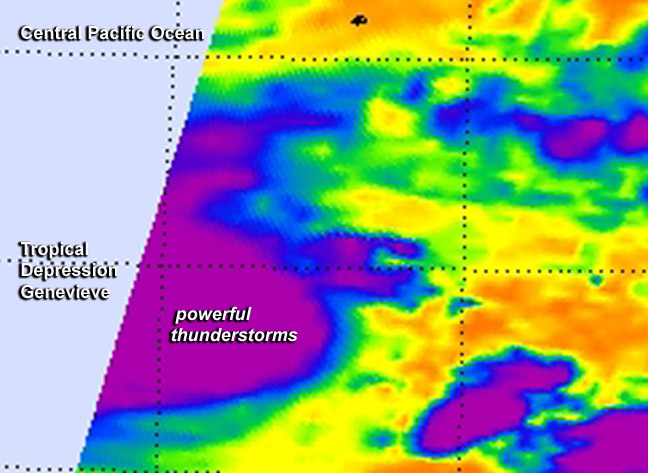NASA Sees Bursts of Thunderstorms in Tropical Depression Genevieve's Center

This false-colored infrared image from NASA's Aqua satellite shows powerful thunderstorms (purple) re-developed around Genevieve's center on August 5 at 8:35 a.m. EDT. Image Credit: NASA JPL, Ed Olsen
A false-colored infrared image created at NASA's Jet Propulsion Laboratory in Pasadena California used data from the Atmospheric Infrared Sounder (AIRS) instrument that flies aboard NASA's Aqua satellite.
The AIRS data showed powerful thunderstorms re-developed around Genevieve's center on August 5 at 8:35 a.m. EDT. That's an indication that there's some punch left in the storm, and that punch could help it strengthen, according to the Central Pacific Hurricane Center (CPHC).
In the August 5 discussion about Genevieve, the CPHC noted “Genevieve has continued to present a bursting pattern during the overnight hours…with the low level circulation center estimated to be under the southeastern portion of an area of very cold cloud tops.”
At 11 a.m. EDT (1500 UTC) today, Tuesday, August 5, Genevieve's maximum sustained winds were near 35 mph (55 kph). The NOAA Central Pacific Hurricane Center notes that gradual strengthening is forecast today through Wednesday, and Genevieve may become a tropical storm later today.
The center of tropical depression Genevieve was located near latitude 11.1 north, longitude 171.1 west. That's about 1,120 miles (1,805 km) southwest of Honolulu, Hawaii and 400 miles (645 km) south-southwest of Johnston Island.
The depression is moving toward the west-northwest near 14 mph (22 kph) and this motion is expected to continue today through Wednesday. The estimated minimum central pressure is 1005 millibars.
NOAA's CPHC calls for slow intensification over the next couple of days as the storm continues to track in a westerly direction. Genevieve is expected to cross the International Date Line in a couple of days and when it does the forecast management of the storm would covered by the Joint Typhoon Warning Center.
Text credit: Rob Gutro
NASA's Goddard Space Flight Center
Media Contact
More Information:
http://www.nasa.gov/content/goddard/genevieve-eastern-pacific-ocean/All latest news from the category: Earth Sciences
Earth Sciences (also referred to as Geosciences), which deals with basic issues surrounding our planet, plays a vital role in the area of energy and raw materials supply.
Earth Sciences comprises subjects such as geology, geography, geological informatics, paleontology, mineralogy, petrography, crystallography, geophysics, geodesy, glaciology, cartography, photogrammetry, meteorology and seismology, early-warning systems, earthquake research and polar research.
Newest articles

Webb captures top of iconic horsehead nebula in unprecedented detail
NASA’s James Webb Space Telescope has captured the sharpest infrared images to date of a zoomed-in portion of one of the most distinctive objects in our skies, the Horsehead Nebula….

Cost-effective, high-capacity, and cyclable lithium-ion battery cathodes
Charge-recharge cycling of lithium-superrich iron oxide, a cost-effective and high-capacity cathode for new-generation lithium-ion batteries, can be greatly improved by doping with readily available mineral elements. The energy capacity and…

Novel genetic plant regeneration approach
…without the application of phytohormones. Researchers develop a novel plant regeneration approach by modulating the expression of genes that control plant cell differentiation. For ages now, plants have been the…





















